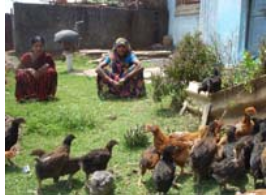Narmada Nidhi - A hybrid variety of chicken
Narmada Nidhi - A hybrid variety of chicken
‘Narmada Nidhi’ is a improved location specific variety of chicken developed by the College of Veterinary Science and Animal Husbandry, Nanaji Deshmukh Pashu Chikitsa Vigyan Vishwa Vidyalaya (Nanaji Deshmukh Veterinary Science University), Jabalpur, Madhya Pradesh. The dual purpose coloured bird is suitable for rural and tribal areas poultry farming in Madhya Pradesh.
Breed development
- It has been developed by crossing Kadaknath (Native chicken breed) with Jabalpur colour (Coloured broiler).
- Parental lines - Kadaknath is a local breed of chicken found in tribal dominated Jhabua and Alirajur districts of MP. The 'Jabalpur colour' breed chicken is an improved breed of chicken developed by the Jabalpur university
- The breed has been developed in such a way that terminal cross has 25% inheritance of Kadaknath breed and 75% inheritance of Jabalpur colour variety.
Features of the breed
- It is a dual purpose dual purpose coloured chicken Variety. They have very attractive multi-colour plumage pattern (black, brown, grey and mixed) and strong body conformation and move fast in free range. These features help in scavenging and also to protect these birds from predators.
- It has been exclusively developed for backyard, free range scavenging and semi intensive systems of rearing.
- Narmadanidhi birds thrive well and adapt to harsh climatic conditions and are preferred by farmers even in remote areas.
- The breed resembles native chicken in appearance but has higher growth and production potential, survive better in sub-optimal nutrition and management.
- The birds attain 700 to 800g at 8 weeks of age under backyard/free-range. Body weight of male and female birds at 20 weeks of age is around 1550 and 1300g, respectively, under backyard conditions.
- The female matures on an average 161 days of age (intensive) and produces 181 eggs in backyard 4 times higher than the local native (45 eggs) and 195 under semi intensive system of management. The eggs are brown shelled eggs and of medium size (50.2g). .


Last Modified : 9/3/2020
© C–DAC.All content appearing on the vikaspedia portal is through collaborative effort of vikaspedia and its partners.We encourage you to use and share the content in a respectful and fair manner. Please leave all source links intact and adhere to applicable copyright and intellectual property guidelines and laws.
RELATED ITEMS
